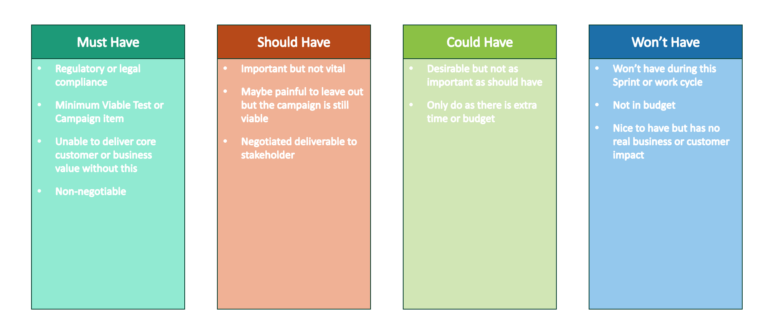
Introduction
Are you feeling overwhelmed as a marketer? Marketing is a fast-paced profession. The digital era has exponentially increased the number of channels, campaigns, and metrics that marketers must manage. When overwhelmed, even the most seasoned marketing veterans can find themselves struggling to keep up.
But what if there was a way to streamline your efforts, prioritize doing the right things, calculate and grow your capacity over time, and deliver more value with less stress? The answer lies in Agile Marketing.
In this blog post, we’ll explore how adopting Agile methodologies can help marketers overcome the feeling of being overwhelmed by adopting three Agile marketing practices:
- Visualizing Your Workflow
- Team-Level Prioritization
- Capacity Measurement and Management
Visualizing Your Workflow
What it Means
The first step to alleviating overwhelm is understanding what’s actually happening. Visualizing your workflow means creating a physical or digital representation of all the tasks, workflow stages, and responsibilities within your marketing projects. It means visualizing where you have too many work items in process leading to that feeling of being overwhelmed. It means identifying tasks that are lingering in the same stage for days at a time, without moving forward, and figuring out what’s blocking that task. It means identifying which stages of the process always seem to be delaying the flow of work towards completion, and figuring out how to change the process to get rid of these bottlenecks.
How to Do It
Kanban boards are an excellent tool for this purpose. A Kanban board is a visual framework that shows the entire workflow in columns representing different stages (e.g., To-Do, In Progress, Review, Done). Each task or deliverable is a card that moves from one column to the next as it progresses.
Building a Kanban board isn’t enough. Everyone has to use it. On a daily basis, you have to examine the board and figure out what you can get done. You have to identify those items that are stuck or blocked and unblock them. You need to figure out when you’re taking on too much work at once, trying to multitask, and not getting work done efficiently. Unless you use your Kanban board as a problem-solving tool, you might as well not use it at all.
Why it Works
Studies show that our brains process visual information 60,000 times faster than text. With a Kanban board, you can quickly identify bottlenecks, track progress, and allocate resources more efficiently. You can also limit Work-In-Process and establish process policies to more efficiently move work through the process.
Team-Level Prioritization
What it Means
Prioritization at the team level involves choosing the most important tasks to focus on based on business or customer outcomes rather than who is the loudest or most senior stakeholder.
How to Do It
There are a number of different ways to prioritize tasks. Let’s look at two of the most common.
ICE Method of Prioritization
- **Impact**: On a scale of 1-10, rate the impact each task will have on customer or business outcomes.
- **Confidence**: Rate your confidence level in the success of each task, again on a scale of 1-10.
- **Ease**: Rate how easy it is to implement each task, on a scale of 1-10.
Calculate the ICE score for each task: ICE Score = (Impact + Confidence + Ease) / 3
Items with high ICE scores should be prioritized over those with lower ICE scores.
MoSCoW method of prioritization
The MoSCoW method is often used in Agile Marketing for prioritization. It categorizes tasks into four categories:
- Must-haves
- Should-haves
- Could-haves
- Won’t-haves

Why it Works
By prioritizing tasks that align with customer needs and business objectives, you ensure that your team’s efforts yield the highest ROI. The MoSCoW method works when you’re rigorous about putting things in the right categories and you’re honest about how much impact projects are going to have and what’s absolutely necessary.
Capacity Measurement and Management
What it Means
Capacity measurement refers to understanding the team’s ability to accomplish a certain amount of tasks of a particular size within a given time frame. This ensures that you’re not overpromising and setting an unsustainable pace that could lead to burnout or subpar work.
How to Do It
Velocity or throughput tracking is a common Agile technique for measuring capacity. It involves calculating the average number of story points (or tasks) completed in past sprints (usually two-week periods) to predict future capacity.
The simplest approach is to categorize tasks into three buckets: small, medium, and large. Assign points to each bucket (also known as t-shirt sizes). For example, you might assign 2 points to each small task, 5 points to each medium task, and 10 points to each large task.
Then track the actual points that you complete in each Sprint (or each time period if you’re practicing Kanban) against the points that you think you’re going to get done (your forecast). Begin using your actual history of delivery to forecast the future, and try to improve your throughput over time.
Why it Works
According to the 6th State of Agile Marketing report, sponsored by the Agile Marketing Alliance in conjunction with AgileSherpas, the biggest benefits marketers get from Agile are the ability to prioritize work more effectively, boost productivity, and improve the quality of their work. Furthermore, 82% of marketers where all marketing teams use Agile, felt that Marketing is very empowered to push back on unplanned work when it doesn′t align to their team′s goals and/or puts high-value work at risk.
Conclusion
Feeling overwhelmed is common in today’s marketing profession. Agile Marketing, with its focus on flexibility, adaptability, and customer-centricity, offers a robust framework for managing complex tasks without losing sight of your objectives. Through techniques like workflow visualization, team-level prioritization, and capacity measurement, you can reclaim control and navigate your work more adeptly. So why stay overwhelmed when you can be Agile?

